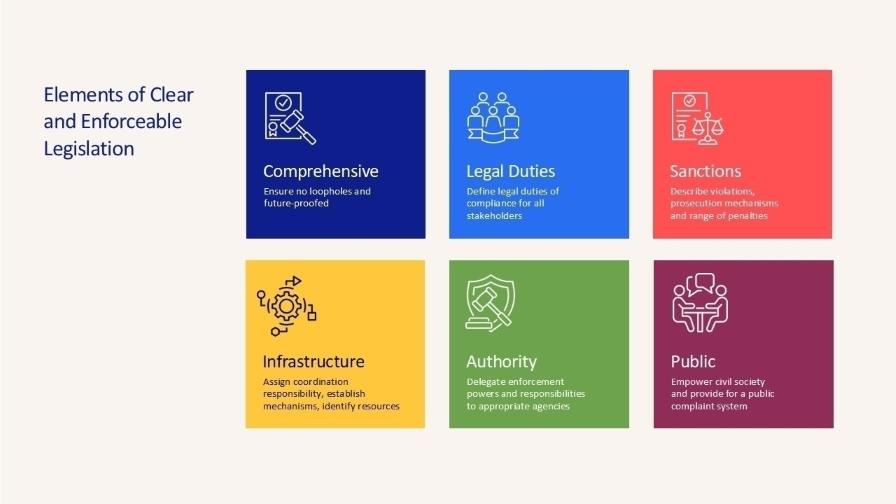Regulations are issued by an executive authority or regulatory agency of a government. They can mandate the specific authority and infrastructure needed to enforce the law, along with detailed implementation rules, legal duties and penalties for non-compliance.
Active and engaged leaders also provide the mandate authorities need to take action: to notify institutional mechanisms, mobilize resources, drive accountability and support enforcement actions. Leaders can issue instructions and orders requiring action from relevant stakeholders and raise the profile of the law.

- Issue regulations describing the detailed requirements and procedures to implement and enforce the tobacco control law. These may include rules, orders, ordinances, guidelines or directives. Once in place, one or several authorities should be assigned responsibility for implementing and enforcing the law.
- Regulations are key; the way they are drafted can significantly impact the effectiveness of the law and whether it can be enforced. If the tobacco control law has loopholes, regulations can sometimes be used to close those gaps.
- For recommendations on regulations, links to key resources and examples of good practice, please click here.
TOP TIP: Regulations are easier to draft and implement when based on a comprehensive law.
- Issue notifications to relevant authorities providing detailed instructions on their roles and responsibilities. Notifications may also need to be issued to sub-national governments, e.g. state, city or sub-district.
- These notifications may be needed to provide authorities with a mandate for allocating resources during annual budget cycles.

- Establish coordination mechanisms for authorities and tiers of government to cooperate, allocate resources and monitor progress. These should be formally notified with clear Terms of Reference. Members should appoint dedicated focal points.
- Laws which empower multiple authorities may require additional mechanisms for conducting joint enforcement actions, such as multi-sectoral Task Forces of authorized officers.
- Some laws may also require formal cooperation agreements between authorities, for example the ministries of health, commerce and customs may sign MOUs to enforce tobacco product regulations.
- For recommendations on coordination and enforcement mechanisms and links to key resources, please click here.
- Ensure systems are in place for handling violations, including accounts for collecting fines.
TOP TIP: Appointing a high-level leader to chair the coordination mechanism can increase buy-in from other stakeholders and demonstrate to inspectors that they have the mandate to issue sanctions.
Build capacity and commitment of key leaders through one-to-one meetings, trainings, mobilizing civil society and engaging media to accelerate and improve interventions.
- Use evidence to motivate and mobilize leaders, such as scientific studies on the burden of tobacco, compliance data and impact modeling for proposed interventions.
- For recommendations and case studies of mobilizing leaders, please click here.
TOP TIP: Aligning tobacco control interventions with existing national or local priorities and programs can increase buy-in from leaders, mobilize resources and make interventions more streamlined and efficient.
- Weak regulations can lead to confusion between agencies on where responsibilities lie, or limit the application of penalties through overly complex sanctioning mechanisms. Find out more about best practices for adopting strong implementing regulations here.
- Lack of support from key political and government leaders can lead to limited resource allocation and unwillingness to issue penalties, limiting the effectiveness of interventions. It is important that leaders see tobacco control as a priority. Learn more about how leaders have been engaged here.
- Tobacco industry interference in the legislative process is well-documented. These tactics can also extend to regulatory interference, leading to weakened rules and overly long grace periods before implementation comes into force. Find out more about how to identify and counter industry tactics here.

In 2020, a smoke-free pilot was started in the East and South districts of Karachi to improve the city’s compliance with Pakistan’s smoke-free law. Modeled on the Smoke-Free City Islamabad project, the initiative was launched by the Commissioner of Karachi. The program aligned with national and regional programs related to other health and sanitation priorities, which the city was able to build political support. The Office of the Commissioner took ownership of the initiative and this was a key factor to building and sustaining support for the initiative, demonstrating its importance to other involved agencies at the Division and District level. The Commissioner himself also participated in high-level awareness and sensitization activities.
Following intensive implementation and enforcement actions, compliance with evidence of smoking indicators rose to above the 85% target threshold in all venue types across both districts by 2024. They also saw an increase in the percentage of venues compliant with no-smoking signage regulations. Qualitative evaluation data collected in 2022 highlighted political commitment and alignment with national priorities as critical factors in strengthening implementation of the smoke-free law.
